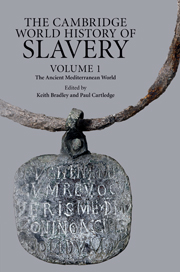Book contents
- Frontmatter
- Contents
- Series editors' introduction
- List of figures
- Acknowledgements
- Introduction
- 1 Slavery in the ancient Near East
- 2 Slaves in Greek literary culture
- 3 Classical Athens
- 4 The Helots: a contemporary review
- 5 Slavery and economy in the Greek world
- 6 The slave supply in classical Greece
- 7 Slavery and the Greek family
- 8 Resistance among chattel slaves in the classical Greek world
- 9 Archaeology and Greek slavery
- 10 Slavery in the Hellenistic world
- 11 Slavery and Roman literary culture
- 12 Slavery in the Roman Republic
- 13 Slavery Under the Principate
- 14 The Roman slave supply
- 15 Slave labour and Roman society
- 16 Slavery and the Roman family
- 17 Resisting slavery at Rome
- 18 Slavery and Roman material culture
- 19 Slavery and Roman law
- 20 Slavery and the Jews
- 21 Slavery and the rise of Christianity
- 22 Slavery in the late Roman world
- Bibliography
- General index
- Index of ancient passages cited
- Index of inscriptions and papyri
- Index of Jewish and Christian Literature Cited
15 - Slave labour and Roman society
Published online by Cambridge University Press: 28 September 2011
- Frontmatter
- Contents
- Series editors' introduction
- List of figures
- Acknowledgements
- Introduction
- 1 Slavery in the ancient Near East
- 2 Slaves in Greek literary culture
- 3 Classical Athens
- 4 The Helots: a contemporary review
- 5 Slavery and economy in the Greek world
- 6 The slave supply in classical Greece
- 7 Slavery and the Greek family
- 8 Resistance among chattel slaves in the classical Greek world
- 9 Archaeology and Greek slavery
- 10 Slavery in the Hellenistic world
- 11 Slavery and Roman literary culture
- 12 Slavery in the Roman Republic
- 13 Slavery Under the Principate
- 14 The Roman slave supply
- 15 Slave labour and Roman society
- 16 Slavery and the Roman family
- 17 Resisting slavery at Rome
- 18 Slavery and Roman material culture
- 19 Slavery and Roman law
- 20 Slavery and the Jews
- 21 Slavery and the rise of Christianity
- 22 Slavery in the late Roman world
- Bibliography
- General index
- Index of ancient passages cited
- Index of inscriptions and papyri
- Index of Jewish and Christian Literature Cited
Summary
INTRODUCTION
Domestic slavery was imagined as existing at Rome from the beginning – it could hardly have been otherwise with a cultural institution so deeply embedded in daily life during the historical period – and its established presence by the middle of the fifth century bc can be presumed from references to manumission and the liability of slave-owners in the Twelve Tables. However, slave labour did not become a significant phenomenon in Roman culture before the fourth century bc, when its rise in importance coincided with a decline in the institution of debt-bondage (nexum), as foreign conquests brought captive manpower to Roman territory and sent citizen colonists abroad, while displaced peasants migrated to the city in search of new means of support. From then on, if not before, agricultural slavery in Italy and, eventually, throughout most of the western empire predominated over all other categories of slave labour in importance for as long as landholding remained the cornerstone of the socio-economic system and the ideal of self-sufficiency was aspired to by the elite. Anecdotal reports in our literary sources of domestic servants in the houses of the kings, like the legendarily servile origins of the sixth king of Rome, Servius Tullius, reflect the conventions of foundation myth-making more surely than they do any historical reality, about which the most that can be said is that the houses of the wealthy of the regal period might seem to require staffing.
- Type
- Chapter
- Information
- The Cambridge World History of Slavery , pp. 311 - 336Publisher: Cambridge University PressPrint publication year: 2011
- 12
- Cited by



